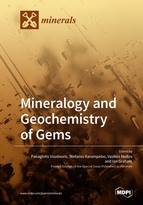Mineralogy and Geochemistry of Gems
A special issue of Minerals (ISSN 2075-163X). This special issue belongs to the section "Mineral Deposits".
Deadline for manuscript submissions: closed (31 December 2018) | Viewed by 226249
Special Issue Editors
Interests: ore minerals; critical metals; magmatic-hydrothermal ore deposits; mineralogy of hydrothermal alterations in porphyry-epithermal systems; mineralogy and genesis of gemstones
Special Issues, Collections and Topics in MDPI journals
Interests: gemology; mineralogy; spectroscopy
Special Issues, Collections and Topics in MDPI journals
Interests: ore deposits; porphyry-epithermal mineralization; mineralogy; geochemistry; fluid inclusions
Special Issues, Collections and Topics in MDPI journals
Interests: gem minerals; ore deposits; mineralogy; volcanic systems; gold mineralization; critical element mineralization
Special Issues, Collections and Topics in MDPI journals
Special Issue Information
Dear Colleagues,
Gems have been used in the manufacture of jewelry and as ornaments since antiquity. Recent statistics have shown that about 15 billion Euros are annually at stake. The purpose of this Special Issue is to present recent advances on the study of various types of gems based on different aspects of research (e.g., geology, trace element geochemistry, inclusion studies, geochronology, spectroscopy, archeogemology), which can be used to constrain the conditions of their formation. A combination of non- and micro-destructive methods, such as UV-Vis-NIR spectroscopy, FTIR spectroscopy, Raman diffusion spectroscopy, EDXRF, LA-ICP-MS, micro-CT and others, may provide valuable information regarding the exact formation, appearance (e.g., color) and treatment of gem materials.
This Special Issue will emphasize on the recent advances in both fundamental and applied studies on gems, as well as the application of mineralogical and geochemical methods to their exploration, provenance and treatment identification from previously known or from new localities worldwide.
Dr. Panagiotis Voudouris
Dr. Stefanos Karampelas
Dr. Vasilios Melfos
Dr. Ian Graham
Guest Editors
Manuscript Submission Information
Manuscripts should be submitted online at www.mdpi.com by registering and logging in to this website. Once you are registered, click here to go to the submission form. Manuscripts can be submitted until the deadline. All submissions that pass pre-check are peer-reviewed. Accepted papers will be published continuously in the journal (as soon as accepted) and will be listed together on the special issue website. Research articles, review articles as well as short communications are invited. For planned papers, a title and short abstract (about 100 words) can be sent to the Editorial Office for announcement on this website.
Submitted manuscripts should not have been published previously, nor be under consideration for publication elsewhere (except conference proceedings papers). All manuscripts are thoroughly refereed through a single-blind peer-review process. A guide for authors and other relevant information for submission of manuscripts is available on the Instructions for Authors page. Minerals is an international peer-reviewed open access monthly journal published by MDPI.
Please visit the Instructions for Authors page before submitting a manuscript. The Article Processing Charge (APC) for publication in this open access journal is 2400 CHF (Swiss Francs). Submitted papers should be well formatted and use good English. Authors may use MDPI's English editing service prior to publication or during author revisions.
Keywords
- gemology
- mineralogy
- geology
- geochemistry
- spectroscopy









